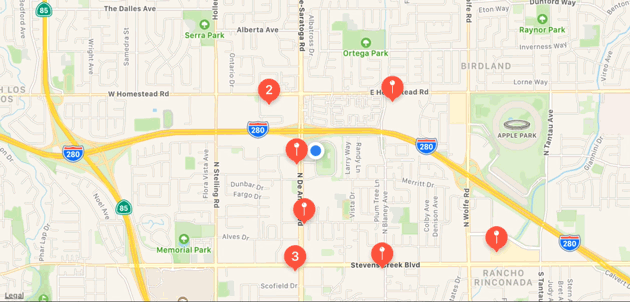Swift-detailCalloutAccessoryView不更新数据
我的mapView有一个自定义注释。我最初使用一些数据在其上设置坐标,标题(例如“第一个标题”),subTitle(例如“第一个地址”),userId和距离(例如0米)属性。我将其添加到mapView和数组中以备后用。一切正常,将其显示在mapView上,然后按一下,标注将显示初始数据。
我后来得到更新,该标注的位置已更改。我遍历数组,并使用坐标,标题(例如“新标题”),subTitle(例如“新地址”)和距离(例如100米)属性的新数据更新标注。我还将标注从原始位置动画化为新位置。动画效果很好,标注从A点移到B点。
问题是,当我点击注释时,标注上会显示旧数据,而不是新数据。
我使用calloutAccessoryControlTapped来推送新的vc。当我在其中放置断点时,自定义引脚将包含所有新数据。该标注似乎发生了错误。
我该如何解决?
我不想从mapView中清除所有注释,所以这不是一个选择。我呼叫mapView.removeAnnotation(customPin)和mapView.addAnnotation(customPin)来解决该销钉的问题,但是当销钉被拔出并重新添加到地图上并且当它动画到它的新位置时,它会闪烁。 / p>
自定义注释
class CustomPin: NSObject, MKAnnotation {
@objc dynamic var coordinate: CLLocationCoordinate2D
var title: String?
var subtitle: String?
var userId: String?
var distance: CLLocationDistance?
init(coordinate: CLLocationCoordinate2D, title: String, subtitle: String, userId: String, distance: CLLocationDistance?) {
self.coordinate = coordinate
self.title = title
self.subtitle = subtitle
self.userId = userId
self.distance = distance
super.init()
}
}
第一次使用初始数据设置注释
firstFunctionThatGetsTheInitialLocation(origLat, origLon) {
let firstCoordinate = CLLocationCoordinate2DMake(origLat, origLon)
let distanceInMeters: CLLocationDistance = self.center.distance(from: anotherUsersLocation)
let customPin = CustomPin(coordinate: firstCoordinate, title: "first title", subtitle: "first address", userId: "12345", distance: distance)
DispatchQueue.main.async { [weak self] in
self?.mapView.addAnnotation(customPin)
self?.arrOfPins.append(customPin)
}
}
第二次使用新数据设置注释
secondFunctionThatGetsTheNewLocation(newCoordinate: CLLocationCoordinate2D, newDistance: CLLocationDistance) {
for pin in customPins {
pin.title = "second title" // ** updates but the callout doesn't reflect it
pin.subTitle = "second address" // ** updates but the callout doesn't reflect it
pin.distance = newDistance // ** updates but the callout doesn't reflect it
// calling these gives me the new data but the annotation blinks and moves really fast to it's new location
// mapView.removeAnnotation(pin)
// mapView.addAnnotation(pin)
UIView.animate(withDuration: 1) {
pin.coordinate = newCoordinate // this updates and animates to the new location with no problem
}
}
}
MapView viewFor注释
func mapView(_ mapView: MKMapView, viewFor annotation: MKAnnotation) -> MKAnnotationView? {
if annotation.isKind(of: MKUserLocation.self) { return nil }
guard let annotation = annotation as? CustomPin else { return nil }
let reuseIdentifier = "CustomPin"
var annotationView = mapView.dequeueReusableAnnotationView(withIdentifier: reuseIdentifier)
if annotationView == nil {
annotationView = MKAnnotationView(annotation: annotation, reuseIdentifier: reuseIdentifier)
annotationView?.canShowCallout = true
annotationView?.calloutOffset = CGPoint(x: -5, y: 5)
annotationView?.rightCalloutAccessoryView = UIButton(type: .detailDisclosure)
annotationView?.image = UIImage(named: "chevronImage")
} else {
annotationView?.annotation = annotation
}
annotationView?.detailCalloutAccessoryView = nil
annotationView?.detailCalloutAccessoryView = createCallOutWithDataFrom(customPin: annotation)
return annotationView
}
创建用于标注的UIView
func createCallOutWithDataFrom(customPin: CustomPin) -> UIView {
let titleText = customPin.title
let subTitleText = customPin.subTitle
let distanceText = subTitle.distance // gets converted to a string
// 1. create a UIView
// 2. create some labels and add the text from the title, subTitle, and distance and add them as subViews to the UIView
// 3. return the UIView
}
1 个答案:
答案 0 :(得分:1)
有几个问题:
-
您需要对要观察的任何属性使用
@objc dynamic限定符。标准标注在title和subtitle上执行Key-Value Observation(KVO)。 (并且注释视图观察到coordinate的变化。) -
如果您要观察
userid和distance,则还必须制作@objc dynamic。请注意,您必须将distance设为非可选,以使其可观察:var distance: CLLocationDistance所以:
class CustomAnnotation: NSObject, MKAnnotation { // standard MKAnnotation properties @objc dynamic var coordinate: CLLocationCoordinate2D @objc dynamic var title: String? @objc dynamic var subtitle: String? // additional custom properties @objc dynamic var userId: String @objc dynamic var distance: CLLocationDistance init(coordinate: CLLocationCoordinate2D, title: String, subtitle: String, userId: String, distance: CLLocationDistance) { self.userId = userId self.distance = distance self.coordinate = coordinate self.title = title self.subtitle = subtitle super.init() } } -
就像我说的那样,标准标注遵循
title和subtitle。虽然必须使注释属性可观察,但是如果要构建自己的detailCalloutAccessoryView,则必须做自己的KVO:class CustomAnnotationView: MKMarkerAnnotationView { private let customClusteringIdentifier = "..." override init(annotation: MKAnnotation?, reuseIdentifier: String?) { super.init(annotation: annotation, reuseIdentifier: reuseIdentifier) canShowCallout = true detailCalloutAccessoryView = createCallOutWithDataFrom(customAnnotation: annotation as? CustomAnnotation) clusteringIdentifier = customClusteringIdentifier } required init?(coder aDecoder: NSCoder) { fatalError("init(coder:) has not been implemented") } deinit { removeAnyObservers() } override var annotation: MKAnnotation? { didSet { removeAnyObservers() clusteringIdentifier = customClusteringIdentifier if let customAnnotation = annotation as? CustomAnnotation { updateAndAddObservers(for: customAnnotation) } } } private var subtitleObserver: NSKeyValueObservation? private var userObserver: NSKeyValueObservation? private var distanceObserver: NSKeyValueObservation? private let subtitleLabel: UILabel = { let label = UILabel() label.translatesAutoresizingMaskIntoConstraints = false return label }() private let userLabel: UILabel = { let label = UILabel() label.translatesAutoresizingMaskIntoConstraints = false return label }() private let distanceLabel: UILabel = { let label = UILabel() label.translatesAutoresizingMaskIntoConstraints = false return label }() } private extension CustomAnnotationView { func updateAndAddObservers(for customAnnotation: CustomAnnotation) { subtitleLabel.text = customAnnotation.subtitle subtitleObserver = customAnnotation.observe(\.subtitle) { [weak self] customAnnotation, _ in self?.subtitleLabel.text = customAnnotation.subtitle } userLabel.text = customAnnotation.userId userObserver = customAnnotation.observe(\.userId) { [weak self] customAnnotation, _ in self?.userLabel.text = customAnnotation.userId } distanceLabel.text = "\(customAnnotation.distance) meters" distanceObserver = customAnnotation.observe(\.distance) { [weak self] customAnnotation, _ in self?.distanceLabel.text = "\(customAnnotation.distance) meters" } } func removeAnyObservers() { subtitleObserver = nil userObserver = nil distanceObserver = nil } func createCallOutWithDataFrom(customAnnotation: CustomAnnotation?) -> UIView { let view = UIView() view.translatesAutoresizingMaskIntoConstraints = false view.addSubview(subtitleLabel) view.addSubview(userLabel) view.addSubview(distanceLabel) NSLayoutConstraint.activate([ subtitleLabel.topAnchor.constraint(equalTo: view.topAnchor), subtitleLabel.leadingAnchor.constraint(equalTo: view.leadingAnchor), subtitleLabel.trailingAnchor.constraint(equalTo: view.trailingAnchor), subtitleLabel.bottomAnchor.constraint(equalTo: userLabel.topAnchor), userLabel.leadingAnchor.constraint(equalTo: view.leadingAnchor), userLabel.trailingAnchor.constraint(equalTo: view.trailingAnchor), userLabel.bottomAnchor.constraint(equalTo: distanceLabel.topAnchor), distanceLabel.leadingAnchor.constraint(equalTo: view.leadingAnchor), distanceLabel.trailingAnchor.constraint(equalTo: view.trailingAnchor), distanceLabel.bottomAnchor.constraint(equalTo: view.bottomAnchor) ]) if let customAnnotation = customAnnotation { updateAndAddObservers(for: customAnnotation) } return view } }
- 为什么我的文本字段没有更新?
- MapKit - 在detailCalloutAccessoryView中显示图像 - 访问mapView.selectedAnnotations不起作用
- MKAnnotationView中的detailCalloutAccessoryView约束
- 为什么我的UICollectionViewCell没有更新?
- 使用detailCalloutAccessoryView作为第三个Annotation属性
- detailCalloutAccessoryView隐藏字幕
- 数据更新但图表不是
- 数组未在Swift中更新
- Swift-detailCalloutAccessoryView不更新数据
- 我写了这段代码,但我无法理解我的错误
- 我无法从一个代码实例的列表中删除 None 值,但我可以在另一个实例中。为什么它适用于一个细分市场而不适用于另一个细分市场?
- 是否有可能使 loadstring 不可能等于打印?卢阿
- java中的random.expovariate()
- Appscript 通过会议在 Google 日历中发送电子邮件和创建活动
- 为什么我的 Onclick 箭头功能在 React 中不起作用?
- 在此代码中是否有使用“this”的替代方法?
- 在 SQL Server 和 PostgreSQL 上查询,我如何从第一个表获得第二个表的可视化
- 每千个数字得到
- 更新了城市边界 KML 文件的来源?
